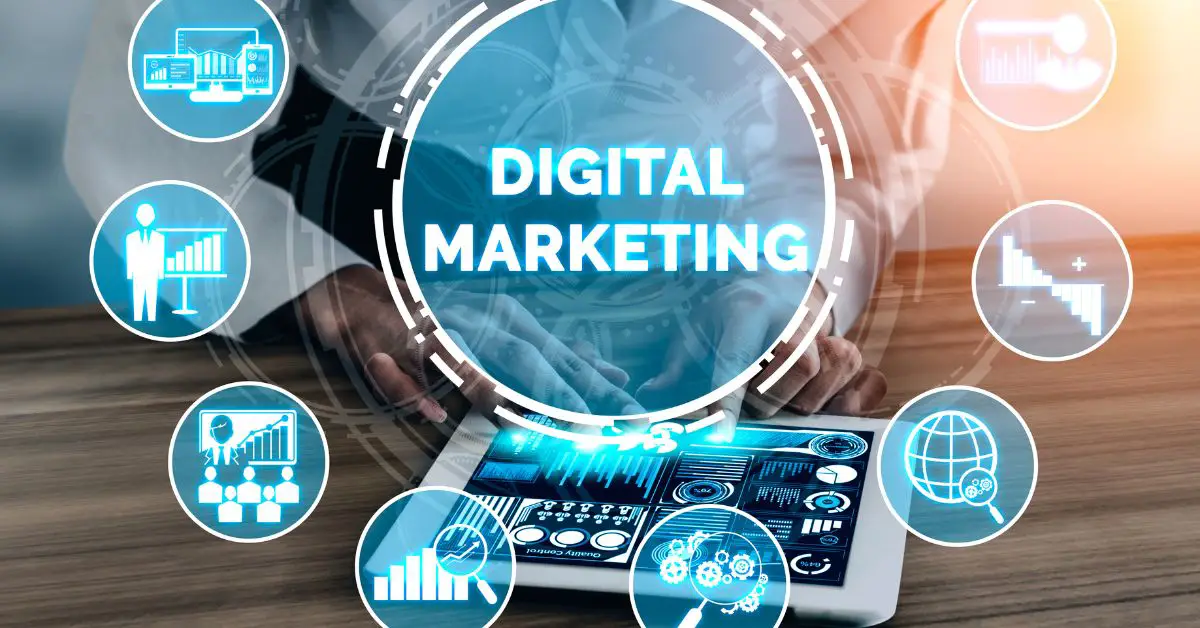Digital marketing has transformed the way businesses and individuals connect with audiences, offering endless opportunities to make money online. Whether you’re promoting your own products, building personal brands, or offering marketing services, the internet has become a marketplace where anyone can thrive.
What makes digital marketing particularly appealing is its accessibility and scalability. Unlike traditional businesses that require significant upfront investment, digital marketing offers low-cost entry points. With a laptop, an internet connection, and the right strategy, you can reach millions of potential customers globally.
Whether you’re a freelancer offering your expertise or an entrepreneur launching a new venture, digital marketing can unlock multiple income streams.In this guide, we will explore how you can leverage the power of digital marketing to generate consistent revenue:
What is Digital Marketing?
Intelligent Ways To Make Money with Digital Marketing
There are various methods to generate income through digital marketing. Each avenue offers unique opportunities, allowing beginners to pick what aligns best with their skills and interests.
1. Affiliate Marketing
What It Is: Affiliate marketing involves promoting other people’s products or services and earning a commission on sales generated through your referral links.
How It Works:
-
- Choose a Niche: Focus on an industry or topic you’re knowledgeable about (e.g., fitness, technology, fashion).
- Join Affiliate Programs: Platforms like Amazon Associates, ShareASale, or ClickBank allow you to sign up for affiliate programs and get unique referral links.
- Promote Products: Use content marketing (blogs, YouTube videos, social media) to recommend products, driving traffic to your affiliate links.
- Earn Commissions: Each sale or action completed via your link earns you a commission
If you are beginner in affiliate marketing, you can read my guide about affiliate marketing.
Best Practices:
-
-
- Build trust with your audience by being transparent about affiliate relationships.
- Focus on products that offer high commissions and are relevant to your niche.
- Utilize SEO and social media to drive targeted traffic to your affiliate links.
-
2. Content Creation & Monetization
Content creation is another great way of digital marketing. The conversion rate of content marketing is very high. You can create content in differnt ways. Here are some of them.
Blogs: Starting a blog in a niche field (e.g., travel, finance, health) allows you to generate income via ads, sponsored posts, and affiliate marketing.
-
- Monetization: Display ads (Google AdSense), affiliate links, and sponsored reviews.
- Strategy: Regularly publish valuable content optimized for SEO to attract organic traffic and engage readers.
YouTube: YouTube allows creators to earn through ad revenue, product sponsorships, and affiliate marketing.
-
- Monetization: YouTube Partner Program (enabling ads), affiliate marketing, and brand sponsorships.
- Strategy: Focus on creating consistent, engaging content, optimize video titles and descriptions for SEO, and promote products naturally in your videos.
Podcasts: Podcasting has become a popular format for building a personal brand and generating revenue.
-
- Monetization: Sponsored segments, affiliate marketing, and listener donations via platforms like Patreon.
- Strategy: Nurture a dedicated listener base with informative, entertaining content.
3. Selling Digital Products
What It Is: You can create and sell digital products like eBooks, online courses, templates, and software that require little to no overhead costs.
How It Works:
-
- Identify a Problem: Find common pain points in your niche, and create a solution through your product (e.g., a course teaching a skill, a toolkit for productivity).
- Build the Product: Invest time upfront to create a high-quality, downloadable product.
- Promote the Product: Use email marketing, social media, and paid advertising to promote your digital products to your target audience.
Popular Platforms:
-
- Teachable: For creating and selling online courses.
- Gumroad: For selling eBooks, templates, and other digital downloads.
- Shopify: For setting up an e-commerce store for digital and physical products.
4. Freelancing as a Digital Marketer
What It Is: Freelancing involves offering digital marketing services (SEO, content creation, social media management, PPC) to businesses and individuals on a project basis.
How It Works:
-
- Identify Your Skillset: Assess your strengths, whether it’s writing, designing, running ad campaigns, or managing social media.
- Find Clients: Use platforms like Upwork, Fiverr, Freelancer, or LinkedIn to find businesses needing your expertise.
- Deliver Results: Provide measurable value, such as increased website traffic, higher engagement, or improved sales.
Freelancing Tips:
-
- Build a portfolio showcasing your previous work or create mock projects to demonstrate your skills.
- Start with smaller gigs to build up testimonials and reviews.
- Charge competitive rates but increase prices as you gain experience and client trust.
5. Dropshipping and E-Commerce
What It Is: Dropshipping allows you to sell products online without holding any inventory. You market the products, and a supplier ships them directly to your customers.
How It Works:
-
- Set Up an Online Store: Use platforms like Shopify or WooCommerce to create your e-commerce website.
- Find Suppliers: Use dropshipping services like Oberlo or AliExpress to source products.
- Market Your Store: Use digital marketing techniques like Google Ads, Facebook Ads, and Instagram influencers to drive traffic to your store.
- Make Sales: When a customer orders, the supplier handles shipping, and you earn the profit margin.
Benefits: Low upfront costs, no need for physical inventory, flexible location.
Challenges: Competitive market, low margins, and reliance on supplier reliability.
Building Your Digital Marketing Portfolio
A strong portfolio is essential for anyone looking to grow their digital marketing career or business. It showcases your skills, builds credibility, and helps attract clients.
1. Starting Your Blog/Website
Why You Need It: A blog or website serves as your digital home base, where you can display your skills, services, case studies, and thought leadership.
Steps:
-
- Choose a Domain Name: Reflect your niche or personal brand.
- Select a Website Builder: WordPress, Wix, or Squarespace are beginner-friendly platforms.
- Create Valuable Content: Write blogs, post case studies, and showcase your skills in SEO, PPC, or social media.
Portfolio Examples:
-
- Case studies detailing a successful SEO strategy for a client.
- Blog posts on industry trends that demonstrate thought leadership.
2. Leveraging Social Media
Building a Personal Brand: Use platforms like LinkedIn, Twitter, or Instagram to share insights, connect with peers, and promote your services.
- Examples:
- Regularly post content related to digital marketing strategies.
- Engage with others in your niche, answer questions, and offer free value to showcase expertise.
3. Creating Case Studies and Testimonials
Importance: Prospective clients or employers are more likely to trust you if you have concrete examples of success.
How to Build Them:
-
- Document Your Results: Collect data (traffic, sales, conversions) from your campaigns.
- Create a Narrative: Explain the problem, the strategy you implemented, and the results you achieved.
- Ask for Testimonials: Request feedback and testimonials from clients you’ve helped to display in your portfolio.
Scaling and Automating Your Digital Marketing Income
Once you’ve built a foundation, it’s time to scale your efforts and automate processes to grow your income.
1. Outsourcing & Hiring Virtual Assistants
Why It’s Important: As your workload grows, you’ll need help with time-consuming tasks like content creation, social media management, and customer service.
Steps:
-
- Identify Repetitive Tasks: Determine tasks you can outsource, such as content writing, graphic design, or ad management.
- Hire VAs or Freelancers: Platforms like Upwork and Fiverr allow you to find skilled workers at affordable rates.
- Focus on High-Value Tasks: As you delegate, focus on strategic areas like scaling campaigns or building partnerships.
2. Investing in Paid Advertising
How Paid Ads Can Help Scale: By investing in PPC (Google Ads, Facebook Ads), you can reach a larger audience, generate more leads, and increase sales.
Steps:
-
- Optimize Your ROI: Continuously test and optimize your ads to ensure you’re getting the most out of your budget.
- Scale Gradually: Start with a small budget, test the waters, and increase spending on high-performing campaigns.
3. Implementing Sales Funnels
What It Is: A sales funnel is a multi-step process that takes potential customers from awareness to purchase through a series of automated marketing actions (emails, content, ads).
Steps:
-
- Create a Lead Magnet: Offer something valuable (e.g., a free eBook or webinar) to get people to sign up for your email list.
- Set Up Email Automation: Use email marketing platforms like ConvertKit or Mailchimp to automatically send a series of emails that build trust and guide leads to a sale.
- Automate Follow-Ups: Ensure that potential customers are nurtured even after visiting your site, increasing conversion rates.
Tracking and Measuring Success in Digital Marketing
Tracking and measuring the success of your digital marketing efforts is critical to ensuring you’re on the right path, optimizing your strategies, and generating the maximum return on investment (ROI). Without proper tracking, it’s impossible to know what’s working and what needs improvement.
1. Key Performance Indicators (KPIs)
- What They Are: KPIs are measurable values that show how effectively you are achieving your objectives. In digital marketing, different KPIs correspond to different channels (SEO, PPC, social media, etc.).
- Examples of KPIs:
- SEO: Organic traffic, search engine rankings, bounce rate, and backlinks.
- PPC: Click-through rate (CTR), cost per click (CPC), conversion rate, and return on ad spend (ROAS).
- Social Media: Engagement rate (likes, shares, comments), follower growth, and social media referral traffic.
- Email Marketing: Open rate, click-through rate (CTR), and conversion rate.
- Content Marketing: Time on page, page views, and lead generation.
- Importance: By defining KPIs, you can assess the effectiveness of your campaigns, pinpoint weaknesses, and make data-driven decisions to improve performance.
2. Using Analytics Tools
- Google Analytics: This free tool helps you understand website traffic, user behavior, and conversion paths. It’s crucial for tracking how users find your site, how long they stay, and what actions they take.
- Social Media Analytics: Platforms like Facebook, Instagram, and Twitter offer built-in analytics that show engagement levels, audience demographics, and the reach of your posts.
- SEO Tools: Tools like SEMrush, Ahrefs, or Moz help you monitor your website’s rankings, keyword performance, and backlink profiles.
- Email Marketing Tools: Mailchimp, ConvertKit, or ActiveCampaign provide detailed reports on open rates, click-through rates, and subscriber engagement.
- Why Use These Tools:
- Data-Driven Decisions: Analytics tools give you actionable insights into what’s driving traffic, engagement, and sales.
- Improvement Opportunities: By tracking performance, you can identify areas where you need to make adjustments (e.g., refining your audience targeting in paid ads or improving the content on underperforming web pages).
3. A/B Testing and Optimization
- What It Is: A/B testing involves comparing two versions of a webpage, ad, or email to determine which performs better. It allows you to optimize your campaigns by continuously testing different elements like headlines, images, or call-to-actions (CTAs).
- How It Works:
- Identify Elements to Test: For example, you can test the effectiveness of two different ad creatives or email subject lines.
- Run Controlled Tests: Send half of your audience one version and the other half the second version.
- Analyze the Results: Use analytics tools to see which version performed better based on your KPIs.
- Best Practices:
- Test one element at a time (e.g., headline vs. call-to-action) to accurately assess its impact.
- Use A/B testing regularly to continuously optimize landing pages, emails, and ads for better results.
4. Setting Benchmarks and Goals
- Why It’s Important: Setting benchmarks based on past performance helps you understand what realistic goals to aim for. For example, if your average website conversion rate is 2%, a goal to increase it to 2.5% in the next quarter is reasonable and measurable.
- Steps:
- Analyze Past Data: Review historical data to establish performance benchmarks.
- Set SMART Goals: Make sure your goals are Specific, Measurable, Achievable, Relevant, and Time-bound.
- Review and Adjust: Regularly monitor progress and adjust goals based on changing business objectives and performance trends.
Overcoming Challenges in Digital Marketing
Digital marketing, though rewarding, comes with its own set of challenges. This section focuses on common hurdles beginners might face and offers strategies to overcome them.
1. Staying Ahead of the Competition
- Challenge: The digital marketing landscape is saturated, making it difficult for beginners to stand out.
- Solution:
- Niche Down: Focusing on a smaller, specific niche can help you build authority and stand out. Instead of marketing to “everyone,” narrow down your target audience.
- Continuous Learning: Digital marketing trends evolve quickly, so stay updated by reading industry blogs (e.g., Moz, HubSpot), taking online courses, and experimenting with new tools and strategies.
2. Budget Constraints
- Challenge: Beginners often have limited budgets, making it hard to invest in paid advertising or premium tools.
- Solution:
- Focus on Organic Growth: Leverage SEO and social media to build your audience without spending heavily on ads.
- Use Free Tools: Many powerful tools like Google Analytics, Canva (for design), and Mailchimp (for email marketing) offer free plans that provide sufficient features for starting out.
- Prioritize ROI: When running ads, start with a small budget and focus on channels that deliver the best returns, like retargeting campaigns that engage people who’ve already shown interest in your content.
3. Algorithm Changes
- Challenge: Constant algorithm updates on Google, Facebook, or Instagram can significantly affect your traffic and visibility.
- Solution:
- Diversify Your Channels: Don’t rely on one platform. Build an email list, focus on SEO, and experiment with different social media platforms to reduce the impact of algorithm changes on a single platform.
- Adapt Quickly: Stay informed about upcoming changes and adjust your strategies accordingly (e.g., update SEO tactics based on Google’s latest algorithm).
4. Content Overload
- Challenge: With so much content available online, it’s hard to capture people’s attention.
- Solution:
- Focus on Quality: Create fewer, but higher-quality content pieces that offer real value, rather than trying to publish as much content as possible.
- Use Visual and Interactive Content: Infographics, videos, and interactive quizzes stand out more and can capture attention better than text-heavy content.
Legal and Ethical Considerations in Digital Marketing
Understanding the legal and ethical aspects of digital marketing is crucial for protecting your brand and building trust with your audience.
1. Data Privacy Regulations (GDPR, CCPA)
- Overview: Data privacy laws like the General Data Protection Regulation (GDPR) in Europe and the California Consumer Privacy Act (CCPA) in the U.S. regulate how companies collect and use customer data.
- Key Rules:
- Consent: Ensure that you have explicit consent from users before collecting or processing their personal data.
- Transparency: Make your privacy policies clear and accessible, detailing how customer data will be used.
- Data Protection: Implement safeguards to protect sensitive customer data from breaches.
- Best Practices:
- Use cookie consent banners on your website to obtain user permission for data tracking.
- Regularly update your privacy policies to comply with local and international laws.
2. Copyright and Intellectual Property
- Challenge: Using copyrighted images, music, or content without permission can lead to legal disputes.
- Solution:
- Use royalty-free or Creative Commons-licensed content.
- Give credit when using content that requires attribution.
- Create original content whenever possible to avoid infringement.
3. Honest and Transparent Advertising
- Overview: Ethics in digital marketing revolve around being truthful in your advertising, using clear disclosures for affiliate links, and avoiding deceptive practices.
- Best Practices:
- Clearly label sponsored posts and ads to avoid misleading consumers.
- Disclose affiliate relationships in blog posts, videos, and emails to maintain transparency.
- Avoid using clickbait headlines that mislead readers or overpromise results.
Future Trends in Digital Marketing
Staying ahead of emerging trends is key to long-term success in digital marketing. This section explores the trends shaping the future of the industry.
1. AI and Machine Learning
- How It’s Shaping Digital Marketing:
- AI-Powered Tools: Chatbots, content creation tools, and predictive analytics are becoming increasingly common.
- Personalization: AI enables hyper-personalized marketing, where businesses can tailor content, emails, and ads based on user behavior and preferences.
- How to Leverage It:
- Use AI tools like Jasper (for content generation) or chatbots to automate customer service.
- Implement machine learning algorithms in paid ads to improve targeting and conversion rates.
2. Voice Search Optimization
- What It Is: As voice assistants like Siri, Alexa, and Google Assistant become more popular, optimizing your website for voice search is becoming critical.
- How to Optimize:
- Use conversational keywords and question-based phrases in your content (e.g., “What is the best way to…?”).
- Focus on local SEO, as many voice searches have local intent (e.g., “find a plumber near me”).
Frequently Asked Questions
How long does it take to start making money with digital marketing?
The time it takes to start generating income from digital marketing varies based on several factors, including the strategy you’re using (e.g., affiliate marketing, paid ads, content creation), your niche, and how much effort you put in. For example, SEO and content marketing can take several months to show results, while paid ads can generate leads and sales almost immediately. On average, beginners can expect to see results within 3-6 months, but consistent effort is key to long-term success.
Do I need a large budget to succeed in digital marketing?
No, you don’t need a large budget to get started. Many successful digital marketers started with minimal investment. You can begin by focusing on organic methods like SEO, social media marketing, and email marketing, which don’t require large upfront costs. As you grow and start earning, you can reinvest in paid strategies like PPC advertising to scale your efforts. Tools like Google Analytics, Canva, and Mailchimp also offer free versions that are powerful enough for beginners.
Is it necessary to have technical skills to succeed in digital marketing?
While having some technical knowledge can be beneficial, it is not a strict requirement to succeed in digital marketing. Many aspects, such as content creation, social media marketing, and affiliate marketing, rely more on creativity, strategy, and communication skills. Additionally, there are numerous user-friendly tools and platforms available, like WordPress for website building, Canva for design, and email marketing tools like Mailchimp, which simplify the technical processes. As you grow, learning some basic SEO, data analytics, and paid advertising strategies can help you further enhance your marketing efforts.
Wrapping Up
The key to long-term success lies in consistent learning, tracking performance, and refining your strategies based on data-driven insights. Whether you’re a beginner exploring affiliate marketing or a seasoned entrepreneur expanding through paid ads, digital marketing’s flexible, scalable nature provides endless possibilities for growth. By staying informed about the latest trends and adapting your approach, you can build a sustainable and lucrative online presence that stands the test of time.







